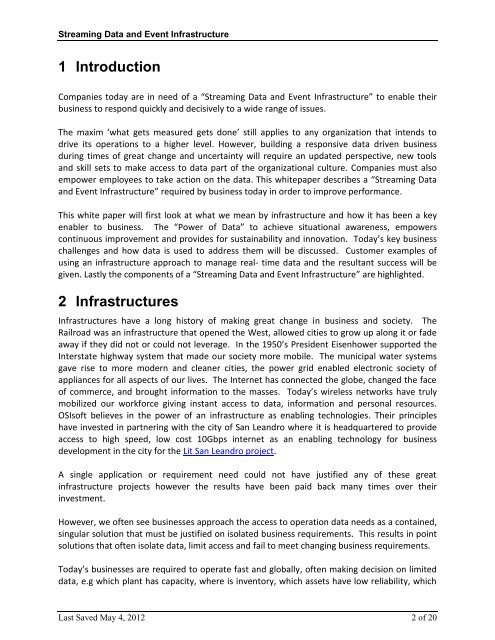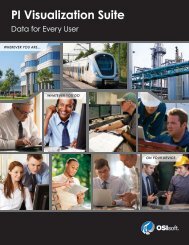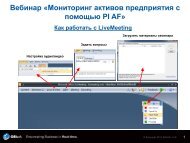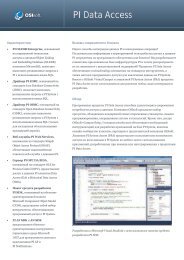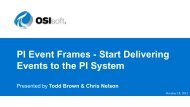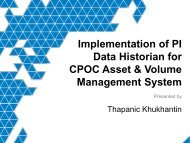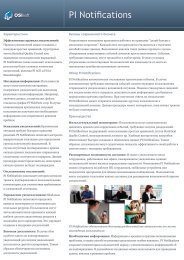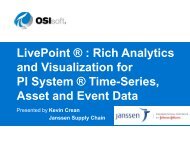Streaming Data and Event Infrastructure - OSIsoft
Streaming Data and Event Infrastructure - OSIsoft
Streaming Data and Event Infrastructure - OSIsoft
You also want an ePaper? Increase the reach of your titles
YUMPU automatically turns print PDFs into web optimized ePapers that Google loves.
<strong>Streaming</strong> <strong>Data</strong> <strong>and</strong> <strong>Event</strong> <strong>Infrastructure</strong><br />
1 Introduction<br />
Companies today are in need of a “<strong>Streaming</strong> <strong>Data</strong> <strong>and</strong> <strong>Event</strong> <strong>Infrastructure</strong>” to enable their<br />
business to respond quickly <strong>and</strong> decisively to a wide range of issues.<br />
The maxim ‘what gets measured gets done’ still applies to any organization that intends to<br />
drive its operations to a higher level. However, building a responsive data driven business<br />
during times of great change <strong>and</strong> uncertainty will require an updated perspective, new tools<br />
<strong>and</strong> skill sets to make access to data part of the organizational culture. Companies must also<br />
empower employees to take action on the data. This whitepaper describes a “<strong>Streaming</strong> <strong>Data</strong><br />
<strong>and</strong> <strong>Event</strong> <strong>Infrastructure</strong>” required by business today in order to improve performance.<br />
This white paper will first look at what we mean by infrastructure <strong>and</strong> how it has been a key<br />
enabler to business. The “Power of <strong>Data</strong>” to achieve situational awareness, empowers<br />
continuous improvement <strong>and</strong> provides for sustainability <strong>and</strong> innovation. Today’s key business<br />
challenges <strong>and</strong> how data is used to address them will be discussed. Customer examples of<br />
using an infrastructure approach to manage real- time data <strong>and</strong> the resultant success will be<br />
given. Lastly the components of a “<strong>Streaming</strong> <strong>Data</strong> <strong>and</strong> <strong>Event</strong> <strong>Infrastructure</strong>” are highlighted.<br />
2 <strong>Infrastructure</strong>s<br />
<strong>Infrastructure</strong>s have a long history of making great change in business <strong>and</strong> society. The<br />
Railroad was an infrastructure that opened the West, allowed cities to grow up along it or fade<br />
away if they did not or could not leverage. In the 1950’s President Eisenhower supported the<br />
Interstate highway system that made our society more mobile. The municipal water systems<br />
gave rise to more modern <strong>and</strong> cleaner cities, the power grid enabled electronic society of<br />
appliances for all aspects of our lives. The Internet has connected the globe, changed the face<br />
of commerce, <strong>and</strong> brought information to the masses. Today’s wireless networks have truly<br />
mobilized our workforce giving instant access to data, information <strong>and</strong> personal resources.<br />
<strong>OSIsoft</strong> believes in the power of an infrastructure as enabling technologies. Their principles<br />
have invested in partnering with the city of San Le<strong>and</strong>ro where it is headquartered to provide<br />
access to high speed, low cost 10Gbps internet as an enabling technology for business<br />
development in the city for the Lit San Le<strong>and</strong>ro project.<br />
A single application or requirement need could not have justified any of these great<br />
infrastructure projects however the results have been paid back many times over their<br />
investment.<br />
However, we often see businesses approach the access to operation data needs as a contained,<br />
singular solution that must be justified on isolated business requirements. This results in point<br />
solutions that often isolate data, limit access <strong>and</strong> fail to meet changing business requirements.<br />
Today’s businesses are required to operate fast <strong>and</strong> globally, often making decision on limited<br />
data, e.g which plant has capacity, where is inventory, which assets have low reliability, which<br />
Last Saved May 4, 2012 2 of 20


